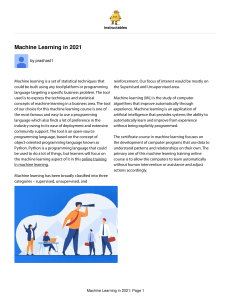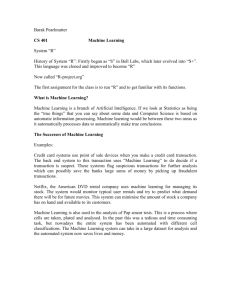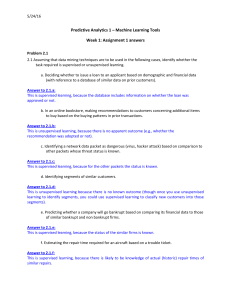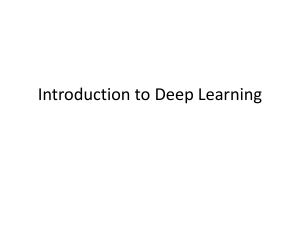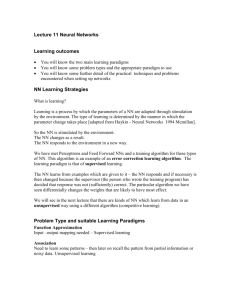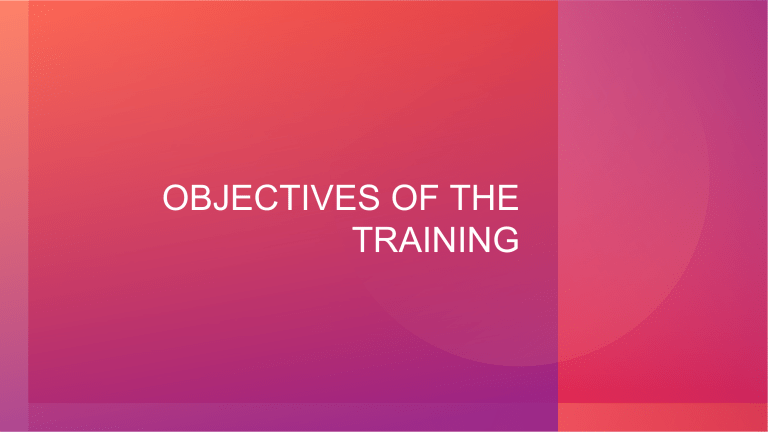
OBJECTIVES OF THE TRAINING DAY 1 - INTRODUCE TO MACHINE LEARNING AND THEIR CONCEPTS - SUPERVISED AND UNSUPERVISED LEARNING - ALGORITHMS - DEEP LEARNING CONCEPTS DAY 2 - K Nearest Neighbor Theorem - Practical uses of KNN - Practice / Exercises using KNN model DAY 3 - Naïve Bayes Algorithm - Computing naïve bayes - Practice / Exercises using naïve bayes DAY 4 - Linear Regression - Computation of Least Square Method (LSM) - Practice / Exercises using Linear Regression model DAY 5 - Deep Learning - Practice case study of mask or with no mask - Practice / Exercises using Linear Regression model What is machine learning? Artificial intelligence (AI) A h u ge set of tools for making comp u ters beha v e intelligentl y Artificial intelligence (AI) A h u ge set of tools for making comp u ters beha v e intelligentl y Machine learning is the most pre v alent subset of AI Defining machine learning : A set of tools for making inferences and predictions from data Defining machine learning : w hat can it do? Predict fu tu re events Will it rain tomorrow? Yes (75% probabilit y) Infer the causes of events and behav iors Why does it rain? Time of the year, h u midit y levels, temperat u re , location , etc Infer pa erns What are the di erent types of weather conditions? Rain, sunny, overcast, fog , etc Defining machine learning : how does it work? Interdisciplinar y mix of statistics and comp u ter science Abilit y to learn w itho u t being e x plicitl y programmed Learn pa erns from e x isting data and applies it to new data Relies on high - q u alit y data ... more to come thro u gho u t the course! Data science Data science is abo u t disco v ering and comm u nicating insights from data MACHINE LEARNING FOR EVERYONE Data science Data science is abo u t making discoveries and creating insights from data Machine learning is o en an important tool for data science work MACHINE LEARNING FOR EVERYONE Machine learning model A statistical representation of a real -w orld process based on data MACHINE LEARNING FOR EVERYONE Machine learning model A statistical representation of a real -w orld process based on data MACHINE LEARNING FOR EVERYONE Machine learning model A statistical representation of a real -w orld process based on data MACHINE LEARNING FOR EVERYONE Machine learning model A statistical representation of a real -w orld process based on data MACHINE LEARNING FOR EVERYONE Let's practice ! Machine learning concepts Three types of machine learning 1) Reinforcement learning 2) Supervised learning 3) Unsupervised learning MACHINE LEARNING FOR EVERYONE Training data Training data : ex isting data to learn from Training a model : when a model is being b u ilt from training data Can take nanoseconds to weeks MACHINE LEARNING FOR EVERYONE Supervised learning training data MACHINE LEARNING FOR EVERYONE Supervised learning training data MACHINE LEARNING FOR EVERYONE Supervised learning training data MACHINE LEARNING FOR EVERYONE Supervised learning training data MACHINE LEARNING FOR EVERYONE Supervised learning training data MACHINE LEARNING FOR EVERYONE After training (supervised learning ) MACHINE LEARNING FOR EVERYONE After training (supervised learning ) MACHINE LEARNING FOR EVERYONE After training (supervised learning ) MACHINE LEARNING FOR EVERYONE Supervised vs unsupervised learning Supervised learning Training data is " labeled " Unsupervised learning Training data only has feat u res Useful for: Anomal y detection Clustering , e.g., dividing data into groups MACHINE LEARNING FOR EVERYONE Unsupervised learning training data MACHINE LEARNING FOR EVERYONE Unsupervised learning training data MACHINE LEARNING FOR EVERYONE After training (unsupervised learning ) MACHINE LEARNING FOR EVERYONE Unsupervised Learning In realit y, data doesn ' t always come w ith labels Requires man u al labor to label Labels are u nkno wn No labels: model is unsupervised and nds its o wn pa erns MACHINE LEARNING FOR EVERYONE Let's practice ! Machine learning workflow Machine learning workflo w MACHINE LEARNING FOR EVERYONE Our scenario O u r dataset : NYC propert y sales from 2015- 2019 Includes: Square feet Neighborhood Year b u ilt Sale price And more ! O u r target : Sale price MACHINE LEARNING FOR EVERYONE Step 1: E x tract features MACHINE LEARNING FOR EVERYONE Step 2: Split dataset MACHINE LEARNING FOR EVERYONE Step 3: Train model MACHINE LEARNING FOR EVERYONE Step 3: Train model MACHINE LEARNING FOR EVERYONE Step 4: Evaluate MACHINE LEARNING FOR EVERYONE Step 4: Evaluate Test dataset : "unseen" data Man y ways to evaluate: What is the a v erage error of the predictions ? What percent of apartments did the model acc u ratel y predict w ithin a 10% margin ? MACHINE LEARNING FOR EVERYONE Step 4: Evaluate MACHINE LEARNING FOR EVERYONE Step 4: Evaluate MACHINE LEARNING FOR EVERYONE Step 4: Evaluate If not , t u ne the model and re - train it: e.g., change the model 's options , add / remo v e feat u res MACHINE LEARNING FOR EVERYONE Machine learning workflo w MACHINE LEARNING FOR EVERYONE Summary of steps 1. E x tract feat u res Choosing feat u res and manip u lating the dataset 2. Split dataset Train and test dataset 3. Train model Inp u t train dataset into a machine learning model 4. Evaluate If desired performance isn't reached: t u ne the model and repeat Step 3 MACHINE LEARNING FOR EVERYONE Let's practice ! https://forms.gle/4udVXNB8opA149GEA
